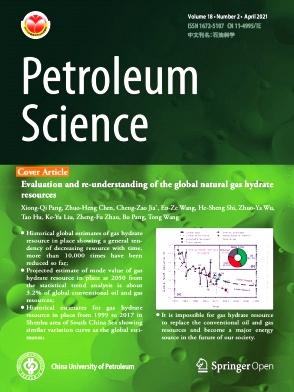Pore formation and evolution mechanisms during hydrocarbon generation in organic-rich marl
IF 6
1区 工程技术
Q2 ENERGY & FUELS
引用次数: 0
Abstract
Marine organic-rich marl is not only a high-quality hydrocarbon source of conventional oil and gas, but also a new type and field of unconventional oil and gas exploration. An understanding of its pore structure evolution characteristics during a hydrocarbon generation process is theoretically significant and has application prospects for the exploration and development of this special type of natural gas reservoirs. This study conducted thermal simulation of hydrocarbon generation under near-geological conditions during a whole process for cylinder samples of low mature marine organic-rich marl in the Middle Devonian of Luquan, Yunnan Province, China. During this process, hydrocarbon products at different evolution stages were quantified and corresponding geochemical properties were analyzed. Simultaneously, field emission scanning electron microscopy (FE-SEM) and low-pressure gas adsorption (CO2, N2) tests were applied to the corresponding cylinder residue samples to reveal the mechanisms of different types of pore formation and evolution, and clarify the dynamic evolution processes of their pore systems. The results show that with an increase in temperature and pressure, the total oil yield peaks at an equivalent vitrinite reflectance (VRo) of 1.03% and is at the maximum retention stage of liquid hydrocarbons, which are 367.51 mg/g TOC and 211.67 mg/g TOC, respectively. The hydrocarbon gas yield increases continuously with an increase in maturity. The high retained oil rate at the peak of oil generation provides an abundant material basis for gas formation at high maturity and over-maturity stage. The lower limit of VRo for organic matter (OM) pore mass development is about 1.6%, and bitumen pores, organic-clay complex pores together with intergranular pores, grain edge seams and dissolution pores constitute a complicated pore-seam-network system, which is the main reservoir space for unconventional carbonate gas. Pore formation and evolution are controlled synergistically by hydrocarbon generation, diagenesis and organic-inorganic interactions, and the pattern of pore structure evolution can be divided into four stages. A pore volume (PV) and a specific surface area (SSA) are at their highest values within the maturity range of 1.9% to 2.5%, which is conducive to exploring unconventional natural gas.
求助全文
约1分钟内获得全文
求助全文
来源期刊

Petroleum Science
地学-地球化学与地球物理
CiteScore
7.70
自引率
16.10%
发文量
311
审稿时长
63 days
期刊介绍:
Petroleum Science is the only English journal in China on petroleum science and technology that is intended for professionals engaged in petroleum science research and technical applications all over the world, as well as the managerial personnel of oil companies. It covers petroleum geology, petroleum geophysics, petroleum engineering, petrochemistry & chemical engineering, petroleum mechanics, and economic management. It aims to introduce the latest results in oil industry research in China, promote cooperation in petroleum science research between China and the rest of the world, and build a bridge for scientific communication between China and the world.
 求助内容:
求助内容: 应助结果提醒方式:
应助结果提醒方式:


